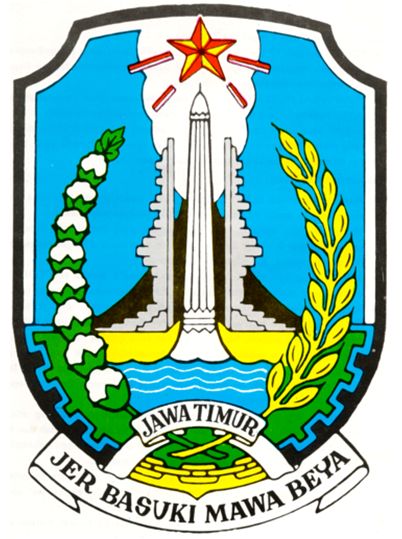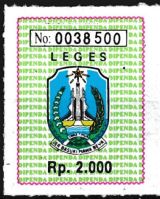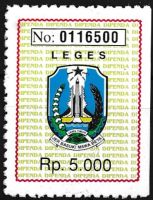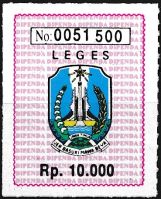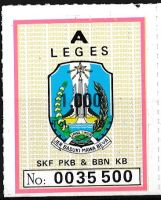Jawa Timur: Difference between revisions
Knorrepoes (talk | contribs) m (Text replace - "[[Literature" to "{{media}} [[Literature") |
Knorrepoes (talk | contribs) m (Text replacement - "===Official blazon===↵↵===Origin/meaning===" to "{| class="wikitable" |+Official blazon |- |'''English''' | blazon wanted |} ===Origin/meaning===") |
||
| (11 intermediate revisions by the same user not shown) | |||
| Line 1: | Line 1: | ||
''' JAWA TIMUR''' | |||
| | [[FIle:jawatimu.jpg|center|Arms (crest) of {{PAGENAME}}]] | ||
| | |||
{| class="wikitable" | |||
|+Official blazon | |||
|- | |||
|'''English''' | |||
| blazon wanted | |||
|} | |} | ||
===Origin/meaning=== | |||
The arms were officially adopted on June 29, 1968. | |||
The gold star means the loftiness and the honour of The One God which it has meaning as the dynamic co-ordination and co-operation between both institutions that are executive and legislative in performing region development. | The gold star means the loftiness and the honour of The One God which it has meaning as the dynamic co-ordination and co-operation between both institutions that are executive and legislative in performing region development. | ||
| Line 21: | Line 24: | ||
slopes of Mt Kelud. Dedicated to the god Siva, the temple was in use for at least three hundred years, from the 14th to 16th centuries. Most of the buildings which can be seen today, however, were constructed during Majapahit's golden century. | slopes of Mt Kelud. Dedicated to the god Siva, the temple was in use for at least three hundred years, from the 14th to 16th centuries. Most of the buildings which can be seen today, however, were constructed during Majapahit's golden century. | ||
Series of tax stamps (1980s): | |||
<gallery widths=250px heights=200px perrow=0> | |||
File:jt2000.jpg|alt=Arms (crest) of Jawa Timur| | |||
File:jt2500.jpg|alt=Arms (crest) of Jawa Timur| | |||
File:jt5000.jpg|alt=Arms (crest) of Jawa Timur| | |||
File:jt10000.jpg|alt=Arms (crest) of Jawa Timur| | |||
File:jtskf.jpg|alt=Arms (crest) of Jawa Timur| | |||
</gallery> | |||
[[Literature]] : -, information from Dina Isyanti, Jakarta | [[Literature]] : -, information from Dina Isyanti, Jakarta | ||
{{id}} | |||
{{media}} | |||
[[Category:Provinces of Indonesia]] | [[Category:Provinces of Indonesia]] | ||
[[Category:Jawa Timur]] | [[Category:Jawa Timur]] | ||
[[Category:Granted 1968]] | |||
Latest revision as of 14:02, 29 January 2024
JAWA TIMUR
| English | blazon wanted |
Origin/meaning
The arms were officially adopted on June 29, 1968.
The gold star means the loftiness and the honour of The One God which it has meaning as the dynamic co-ordination and co-operation between both institutions that are executive and legislative in performing region development.
The yellow rice grains and the cotton symbolise prosperity of food and clothing.
The monument refers to the "Tugu Pahlawan", a monument of the heroic battle of the Surabaya people against the Dutch Colonial Forces in 1945.
The motto "Jer Basuki Mawa Bea", is a famous Javanese slogan, which means "Achievements are only won through sacrifice".
The temple refers to the Candi Panataran (Panataran Temple). The Penataran is the largest and most important Hindu temple complex in East Java. It lies just 10 kilometres north of Blitar on the lower slopes of Mt Kelud. Dedicated to the god Siva, the temple was in use for at least three hundred years, from the 14th to 16th centuries. Most of the buildings which can be seen today, however, were constructed during Majapahit's golden century.
Series of tax stamps (1980s):
Literature : -, information from Dina Isyanti, Jakarta
Indonesia heraldry portal
This page is part of the Indonesia heraldry portal |
Heraldry of the World |
|
Civic heraldry:
|
Other heraldry: |
Contact and Support
Partners:
Your logo here ?
Contact us
© since 1995, Heraldry of the World, Ralf Hartemink 
Index of the site
